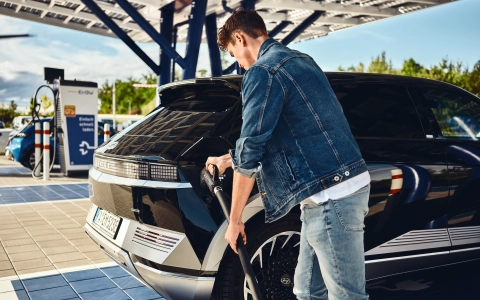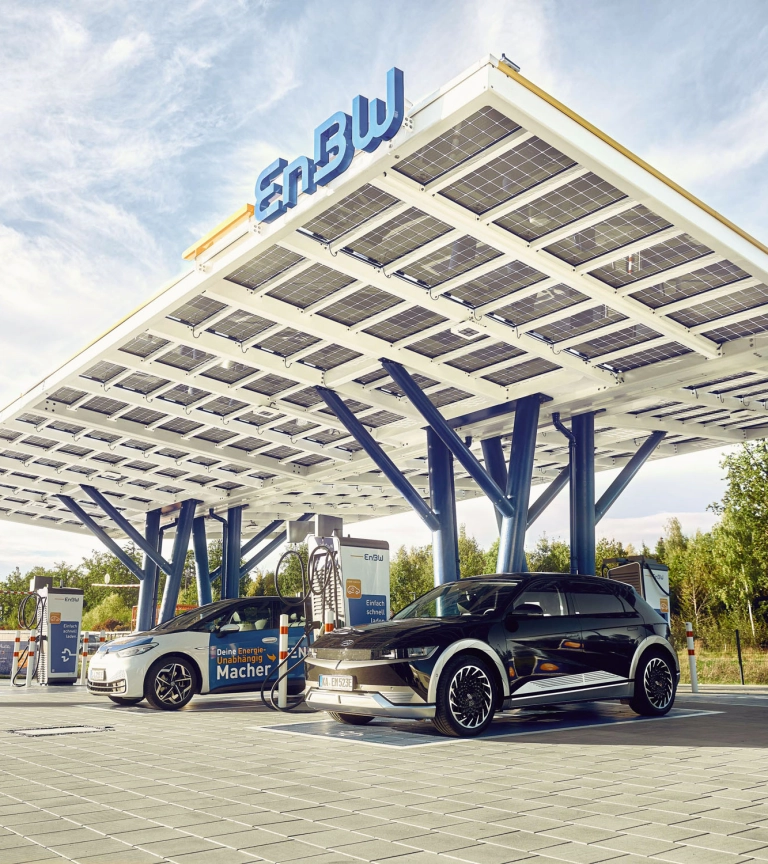
Photovoltaics for electric cars
Never fuel up again.
Charge your EV with solar electricity
The future belongs to electromobility But where do electric cars get their electricity? The best and most sustainable method is to charge your EV using solar-powered electricity from your own photovoltaic system! Not only is this method good for the environment and the climate, it also makes good financial sense to charge your EV using electricity from photovoltaics. This guide sets out what you need to achieve this and the advantages this solution offers.

The future belongs to electromobility
The future of cars lies in electromobility, also known as e-mobility, which is making great strides forward in Germany and beyond. The strong growth of electromobility in Germany is reflected in rapidly increasing EV registration figures. Yet, this is just the beginning. By 2030, electric cars will account for one-third of all newly registered vehicles.
Our experts would be happy to advise you, free of charge
Get advice about using photovoltaics to support your e-mobility!
Advantages of e-mobility: Good for the climate – and for you
Electromobility is on the rise because it offers clear advantages, both for drivers and for society as a whole. The most significant advantages of e-mobility are:
- Clean: Low emissions of greenhouse gases and air pollutants
- Quiet: Less noise pollution
- Convenient: Charge at home or on the go instead of searching for petrol stations
- Dynamic: An excellent driving experience, guaranteed
- Affordable: Low mobility costs
Charging your electric car with self-generated electricity from your own solar power system not only makes you more independent but also enables you to get around more cost-efficiently.
Charge your electric car with photovoltaics and save money
An electric car has lower running costs than a petrol or diesel car – even when charged with electricity from the grid instead of a photovoltaic system. If you drive around 15,000 kilometres a year, the annual running costs of an electric car will be around €400 cheaper. You save even more if you charge your EV with solar electricity from your own photovoltaic system. As self-generated electricity is markedly cheaper than the electricity mix, you save a further €4 for every 100 kilometres you drive with your EV.

What do I need to charge my EV with photovoltaics?
If you would like to charge your electric car with self-generated electricity, you need a photovoltaic system – and a house with a roof capable of supporting a solar power system. If you want to supply your own home with electricity, you should also invest in an electricity storage system, because otherwise you’ll have to feed surplus solar electricity into the grid and buy electricity back from the grid at higher prices when you need it. You can have your wallbox – your domestic EV charging point – installed in your garage or car port, either fixed to the wall or as a free-starting pillar. All that matters is that you have it installed on your private property.
What components do I need to charge my EV?

A photovoltaic system
Thinking of using a photovoltaic system to generate electricity to charge your EV? Electric cars increase your electricity needs. So, you should plan a PV system that is as big as possible. Take advantage of your roof with the help of SENEC solar modules. Your SENEC specialist partner can calculate how big your photovoltaic system needs to be – and what will fit on your roof.
-

A battery energy storage system
People who want to supply their own solar-powered electricity need a storage device such as SENEC.Home so that they can use solar electricity around the clock. If SENEC.Home is intelligently networked with your PV system and wallbox, you can always charge your electric car with solar electricity when the sun is shining. This enhances your energy independence.
-

A charging station for your e-car at home
Charge your EV at home with a domestic charging point called a wallbox. Intelligently networked with the PV system and battery, the wallbox draws as much electricity as possible from your solar power system. In the SENEC.App, you can select between solar-optimised charging or charging your car as fast as possible.

Cloud to go
Would you like to charge your solar electricity on the go and make your e-mobility solution genuinely independent? If so, sign up for SENEC.Cloud to go and access your solar electricity at over 400,000 charging points throughout Europe in the EnBW Hypernetz using the straightforward app. If you want to be independent, go all the way!
Our experts would be happy to advise you, free of charge
Get advice about using photovoltaics to support your e-mobility!

What charging cables are available for EV charging?
There are two types of charging cable: Mode 2 and Mode 3. Mode 2 cables are often supplied with EVs as standard so that they can be connected to a household electrical socket in an emergency. Charging with a wallbox requires a Mode 3 cable.

What are the different EV connector types?
There are various connectors available for charging an electric car. The Type 2 connector has won through and become the market standard in Germany and Europe, and is inserted into the side of the wallbox. This is also the connector to use with the SENEC.Wallbox. There is also the CCS connector, effectively an upgraded Type 2 connector, which has a fast-charging function and supports AC and DC charging. Other connector types do exist but are mainly prevalent in Asia.
Charging your electric car with your own wallbox
If you want to charge your EV at home, you need to have a wallbox. So, what are the biggest advantages of a domestic charging point for independent e-mobility?
- High charging capacity
- Your charging point is always available and offers a safe, effective place to charge your EV
- You can charge your electric car using your photovoltaic system and electricity storage system – and stay mobile with self-generated electricity.
On the road with the EnBW HyperNetz
Our parent company, EnBW Energie Baden-Württemberg, is committed to driving electromobility forward. Among other services, EnBW operates the largest fast-charging network in Germany. If you choose SENEC.Cloud to go, you will gain access to the largest charging network in the German-speaking world and a total of over 400,000 charging points in 16 European countries. You can access the solar electricity you generated at any one of these stations!

Government funding for your charging point
Government funding is available to help you purchase an electric car and install a wallbox.
Don’t miss out on funding for your electric car and secure a subsidy to help you embrace electromobility.
NOTE: Funding available across Germany through the KfW 440 programme has now been exhausted. We will provide details of new subsidies as soon as they become available.

